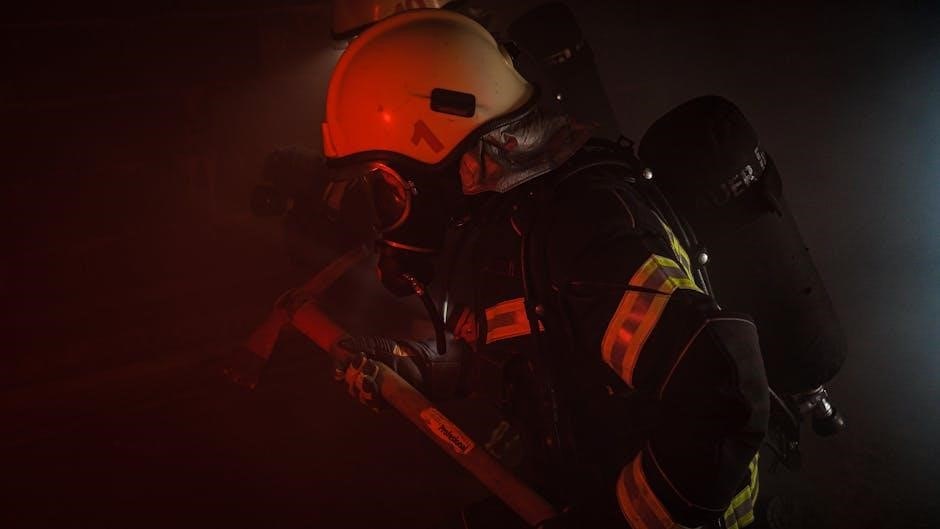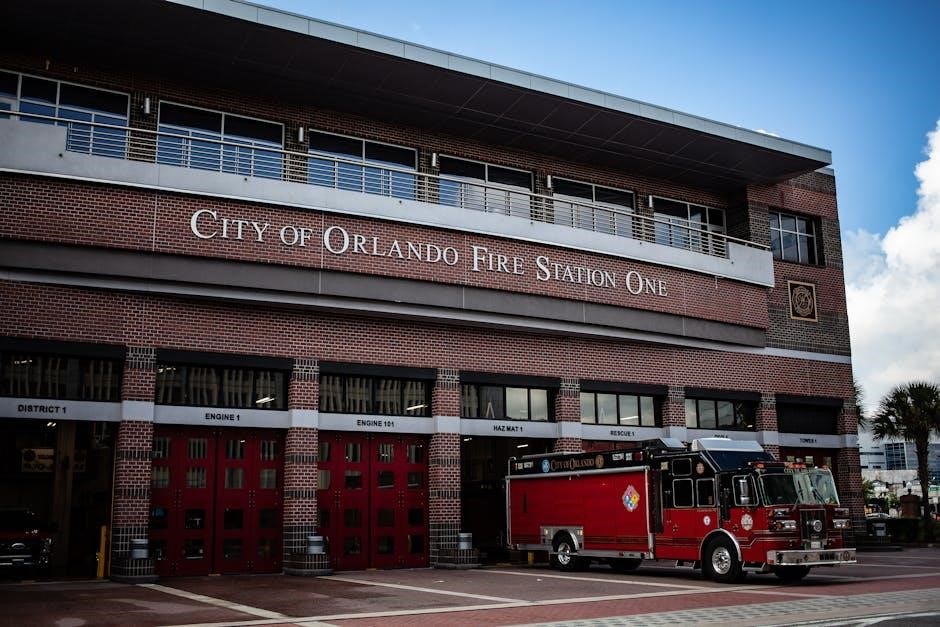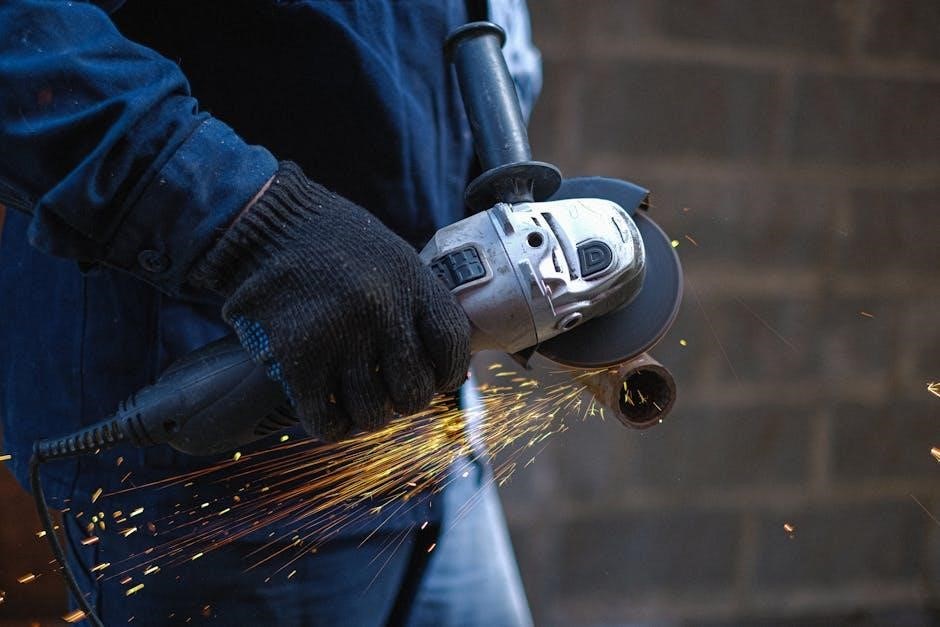NFPA 268 is a standard by the National Fire Protection Association (NFPA) for testing exterior wall assemblies’ ignitability under radiant heat exposure.
It provides a fire safety engineering method to assess materials’ susceptibility to ignition, ensuring compliance with building codes and fire protection standards.
1.1 Overview of the Standard
NFPA 268 provides a standardized test method for determining the ignitability of exterior wall assemblies using a radiant heat energy source. It assesses how materials respond to fire exposure, ensuring compliance with fire safety regulations. The standard is essential for evaluating the fire performance of building materials and assemblies, particularly in preventing fire spread. First introduced in 1996, NFPA 268 has evolved to include updated test procedures and criteria for measuring ignition propensity. It plays a critical role in fire safety engineering and material selection for construction projects.
1.2 Importance in Fire Safety
NFPA 268 is crucial for ensuring fire safety in buildings by assessing the ignitability of exterior wall assemblies. It helps prevent fire spread by identifying materials that resist ignition under radiant heat exposure. This standard is vital for protecting lives and property, as it ensures exterior walls can withstand fire hazards. By providing clear test methods, NFPA 268 enables architects, engineers, and safety professionals to design safer buildings. Its implementation contributes significantly to fire safety engineering and compliance with international building codes, reducing fire-related risks and promoting public safety.
1.3 Brief History of NFPA 268
NFPA 268 was first introduced in 1996 to address the need for standardized testing of exterior wall assemblies’ ignitability. The initial edition established a method using a radiant heat energy source to simulate fire exposure. Over the years, the standard has been updated to reflect advancements in fire safety engineering and testing technologies. The 2017 and 2021 revisions incorporated new references and clarified procedures, ensuring alignment with international building codes. NFPA 268 has become a cornerstone in fire protection, providing essential data for material selection and building design.
Purpose and Scope of NFPA 268
NFPA 268 provides a standardized test method to assess the ignitability of exterior wall assemblies under radiant heat exposure, ensuring fire safety and material performance evaluation.
2.1 Objective of the Standard
The primary objective of NFPA 268 is to provide a reliable test method for determining the ignitability of exterior wall assemblies when exposed to radiant heat energy and a pilot ignition source. This standard aims to evaluate how materials respond to fire conditions, ensuring their safety in real-world applications. By establishing consistent testing protocols, NFPA 268 helps architects, engineers, and builders select materials that meet fire safety requirements, reducing the risk of fire spreading in buildings. This aligns with broader fire protection goals and building code compliance.
2.2 Scope of Application
NFPA 268 applies to exterior wall assemblies, defining a standardized method to assess their ignitability under radiant heat exposure and pilot ignition. The scope includes testing materials’ susceptibility to fire spread, ensuring compliance with fire safety requirements. It provides criteria for evaluating assemblies exposed to specific heat flux levels, aligning with International Building Code (IBC) standards. This standard is crucial for determining fire-resistant materials and ensuring structural integrity in fire scenarios, aiding in the selection of safe, compliant building components.
2.3 Key Definitions and Terminology
NFPA 268 defines critical terms like ignitability, referring to a material’s susceptibility to catching fire under specific conditions. Radiant heat flux is the measure of heat energy exposure, while pilot ignition source describes the spark or flame initiating combustion. Test specimen conditioning ensures materials are prepared consistently for testing. These definitions provide clarity and standardization, enabling accurate assessment of exterior wall assemblies’ fire performance. Understanding these terms is essential for interpreting test results and applying the standard effectively in fire safety engineering and compliance scenarios.

Testing Methods and Procedures
NFPA 268 outlines testing methods using a radiant heat energy source and a pilot ignition source to assess exterior wall assemblies’ ignitability under controlled conditions.
These procedures ensure consistent evaluation of fire performance for compliance with safety standards.
3.1 Radiant Heat Energy Source
NFPA 268 employs a radiant heat energy source to simulate real-world fire exposure conditions. The source is calibrated to deliver a consistent heat flux, typically 12.5 kW/m², ensuring accurate testing of exterior wall assemblies.
This method evaluates how materials respond to radiant heat, providing critical data on ignition propensity and fire spread potential. The standardized approach ensures reliable results for fire safety assessments;
3.2 Pilot Ignition Source
NFPA 268 incorporates a pilot ignition source to simulate real-world fire scenarios, where embers or sparks might ignite materials. This source is introduced after exposing the test specimen to radiant heat, assessing its susceptibility to sustained flaming under combined conditions.
The pilot ignition source is typically a propane burner or similar device, applied to the specimen’s surface. The test evaluates whether the material ignites and sustains flames for more than five seconds, providing critical data for fire hazard assessments.
3.3 Test Specimen Conditioning
Test specimens for NFPA 268 are conditioned to ensure consistent and reliable results. Conditioning involves exposing materials to controlled environmental conditions, such as temperature and humidity, to mimic real-world scenarios. This step ensures that the specimens’ properties reflect their expected behavior in actual fire conditions. Proper conditioning is critical for accurate assessment of ignition resistance and fire performance, ensuring compliance with fire safety standards.

Understanding Test Results
NFPA 268 test results determine if exterior wall assemblies meet fire safety criteria, assessing ignitability and performance under specified radiant heat exposure conditions.
4.1 Ignitability Criteria
NFPA 268 establishes specific criteria to evaluate the ignitability of exterior wall assemblies under controlled radiant heat and pilot ignition conditions.
The test measures the assembly’s resistance to ignition, assessing whether sustained flaming occurs within a 20-minute exposure to a 12.5 kW/m² heat flux.
Results are categorized based on the time to ignition and the presence of flaming, providing clear pass/fail outcomes to ensure compliance with fire safety standards.
4.2 Interpretation of Data
NFPA 268 data interpretation involves analyzing the time to ignition and the presence of sustained flaming under controlled radiant heat exposure.
The results determine whether an exterior wall assembly meets the required fire performance criteria, specifically the 20-minute exposure duration.
Data interpretation is critical for assessing material suitability, ensuring compliance with fire safety standards, and informing design decisions in construction projects.

Compliance with International Building Codes
NFPA 268 aligns with International Building Code (IBC) requirements, addressing fire performance and separation distances to ensure safe construction and material use in buildings.
5.1 Relationship with IBC Requirements
NFPA 268 complements International Building Code (IBC) requirements by providing a method to assess fire performance of exterior wall assemblies. The standard uses a radiant heat flux exposure calibrated to simulate fire separation distances as specified in IBC Table 1406.2.1.1.2. This alignment ensures materials meet IBC criteria for ignitability and fire spread. NFPA 268 test results determine whether assemblies comply with IBC fire performance requirements, aiding in the selection of materials for safe building construction. This relationship ensures harmonized fire safety standards in building design and execution.
5.2 Fire Separation Distances
NFPA 268 establishes a method to determine fire separation distances by simulating radiant heat exposure. The standard’s test procedure aligns with Table 1406.2.1.1.2 of the IBC, ensuring accurate fire performance assessment. By measuring ignitability under controlled conditions, NFPA 268 helps verify if materials meet fire safety criteria for specific separation distances. This ensures safe building construction by maintaining required fire resistance and preventing fire spread. The standard’s approach supports compliance with IBC requirements, providing a reliable basis for fire separation distance determinations in various construction scenarios.
NFPA 268 and Other Fire Protection Standards
NFPA 268 complements other fire protection standards like NFPA 285 and NFPA 259, providing a comprehensive approach to fire safety in building construction and materials testing.
6.1 NFPA 285 and Exterior Wall Assemblies
NFPA 285 provides a standardized method for testing exterior wall assemblies to evaluate fire propagation characteristics, complementing NFPA 268’s focus on ignitability. While NFPA 268 assesses how easily materials ignite under radiant heat, NFPA 285 examines the potential for fire spread within wall assemblies. Together, these standards ensure a comprehensive evaluation of fire performance, critical for meeting building code requirements and enhancing fire safety in construction. By addressing both ignition and propagation, these standards provide a robust framework for material selection and building design.
6.2 NFPA 259 and Heat Release Rates
NFPA 259 measures the heat release rate of building materials, providing critical data on how materials contribute to fire growth. While NFPA 268 focuses on ignitability, NFPA 259 assesses the energy released during combustion, helping to evaluate a material’s fire hazard potential. This standard complements NFPA 268 by offering a more comprehensive understanding of fire behavior, enabling better decision-making in material selection and fire safety design. Together, these standards enhance the ability to predict and mitigate fire risks in buildings.
Significance in Fire Safety Engineering
NFPA 268 significantly enhances fire safety engineering by providing standardized methods to assess material ignitability, crucial for designing safer buildings and mitigating fire risks effectively.
7.1 Role in Material Selection
NFPA 268 plays a critical role in material selection by providing standardized testing methods to evaluate exterior wall assemblies’ ignitability under radiant heat and pilot ignition sources. This helps engineers and architects identify materials that resist ignition, ensuring compliance with fire safety standards. By assessing how materials perform under specific fire conditions, NFPA 268 aids in selecting products that minimize fire risks, aligning with building codes and enhancing overall fire safety engineering practices.
7.2 Contribution to Building Design
NFPA 268 significantly impacts building design by providing critical data on exterior wall assemblies’ fire performance. This standard ensures that designs incorporate materials and systems proven to resist ignition under specific fire scenarios, enhancing overall fire safety.
By aligning with international building codes, NFPA 268 helps architects and engineers create structures that meet rigorous fire safety standards. Its testing protocols enable informed decisions, contributing to safer and more resilient building designs.

Applications in Construction and Architecture
NFPA 268’s standardized testing methods ensure exterior wall assemblies meet fire safety criteria, directly influencing material selection and design strategies in modern construction. By providing clear ignitability data, the standard enables architects to create safer, code-compliant buildings. Its focus on radiant heat exposure and ignition resistance helps optimize designs for fire performance, ultimately contributing to more resilient structures that align with international building codes and fire protection goals.
8.1 Exterior Wall Assembly Design
NFPA 268 plays a crucial role in exterior wall assembly design by providing standardized methods to assess ignitability under radiant heat exposure. Architects and designers use these test results to select materials and design assemblies that meet fire safety requirements. The standard’s focus on simulating real-world fire scenarios ensures that exterior walls are engineered to resist ignition and minimize fire spread. By adhering to NFPA 268, professionals can create structures that comply with building codes, enhance fire safety, and maintain aesthetic and functional design goals.
8.2 Fire-Resistant Materials
NFPA 268 provides critical guidance for evaluating fire-resistant materials used in exterior wall assemblies. The standard’s testing methods help determine how materials perform under radiant heat exposure, ensuring they meet fire safety requirements. Materials that pass NFPA 268 tests, such as foam plastics and claddings, demonstrate reduced ignitability and flame spread. This ensures compliance with building codes and enhances fire safety in construction projects. Architects and engineers rely on these evaluations to select materials that balance safety, durability, and aesthetic design goals;

Case Studies and Real-World Applications
NFPA 268 has been successfully implemented in real-world scenarios, such as testing exterior wall assemblies in high-rise buildings, ensuring fire safety and compliance with international codes.
9.1 Successful Implementation Examples
Several case studies highlight the effective use of NFPA 268 in fire safety evaluations. For instance, the testing of exterior wall assemblies in high-rise buildings demonstrated compliance with international building codes. SwRI’s laboratory successfully conducted NFPA 268 tests, showcasing the standard’s practical application. Additionally, Thermax foam plastic insulations were evaluated, proving their ability to meet NFPA 268 requirements. These examples underscore the standard’s role in ensuring fire-resistant materials are used in construction, thereby enhancing public safety and adhering to regulatory norms.
9.2 Lessons Learned from Testing
Testing under NFPA 268 has revealed critical insights into material performance under fire conditions. A key lesson is the importance of precise radiant heat flux calibration to simulate real-world scenarios. Additionally, the standard’s emphasis on sustained flaming criteria has highlighted the need for durable, fire-resistant materials. These findings have led to improved test methodologies and material selections, ultimately enhancing fire safety in construction projects. The lessons underscore the value of adherence to NFPA 268 in ensuring reliable and repeatable test outcomes.

Future Developments and Updates
NFPA 268 is expected to incorporate advancements in testing technology and updated fire safety requirements, ensuring alignment with evolving building codes and material innovations.
10.1 Upcoming Revisions
Future updates to NFPA 268 will focus on refining test methods and incorporating new fire safety advancements. Revisions aim to enhance accuracy in measuring ignitability and address emerging materials. Updates may include expanded test parameters and clarifications on radiant heat flux application. The standard will align with international building codes, ensuring consistency in fire protection requirements. Additionally, revisions will reflect advancements in testing technology, providing clearer guidelines for exterior wall assembly evaluations. These changes will strengthen the standard’s role in fire safety engineering and material compliance.
10.2 Advances in Testing Technology
Recent advancements in testing technology have improved the precision of NFPA 268’s radiant heat flux measurements. New equipment allows for more accurate simulations of real-world fire conditions, enhancing the reliability of ignitability assessments. Automation and data analysis tools now enable faster and more detailed evaluations of exterior wall assemblies. These technological improvements ensure that test results are consistent and actionable, supporting better material selection and compliance with fire safety standards. Innovations in sensor technology and software integration further strengthen the standard’s effectiveness in modern fire protection applications.

How to Obtain the NFPA 268 PDF
The NFPA 268 PDF can be purchased directly from the NFPA website or accessed through subscription options, ensuring access to the latest updates and guidelines.
11.1 Official Sources
The NFPA 268 PDF is available for purchase through the NFPA official website. Additionally, it can be accessed via subscription to NFPA’s document library, which provides full access to all updated standards, including future revisions and amendments. This ensures users receive the most current version of the standard, critical for compliance with fire safety regulations and testing methodologies. Subscriptions offer cost-effective solutions for professionals requiring regular updates and comprehensive access to NFPA documents.
11.2 Subscription and Access Options
NFPA offers flexible subscription options for accessing the NFPA 268 PDF. Users can choose between annual or multi-year subscriptions, providing uninterrupted access to the standard and any updates. Subscriptions include digital access through the NFPA website, allowing users to download or view the document anytime. This option is ideal for professionals requiring frequent reference to the standard. Additionally, subscription packages often include access to other related NFPA standards, enhancing cost-effectiveness for those needing multiple documents. Visit the NFPA website for detailed subscription plans and benefits.
NFPA 268 is a critical standard for assessing exterior wall assemblies’ fire safety, ensuring compliance with building codes and promoting safer construction practices globally.
12.1 Summary of Key Points
NFPA 268 provides a standardized method to assess the ignitability of exterior wall assemblies under radiant heat exposure, ensuring fire safety compliance. The test measures susceptibility to ignition, offering critical data for material selection and building design. By correlating with the International Building Code, it helps determine fire separation distances, enhancing structural integrity. NFPA 268 complements other standards like NFPA 285 and NFPA 259, reinforcing fire protection measures. Regular updates ensure the standard remains aligned with advancing technologies and fire safety requirements, making it indispensable for modern construction practices.
12.2 Final Thoughts on Implementation
NFPA 268 is a critical tool for ensuring fire safety in modern construction, providing clear guidelines for assessing exterior wall assemblies. Its implementation is essential for meeting fire safety standards, as it helps identify materials that can resist ignition under specific conditions. By adhering to NFPA 268, architects and builders can design safer structures while complying with international building codes. Regular updates to the standard emphasize the importance of staying current with advancing fire protection technologies and methodologies.
